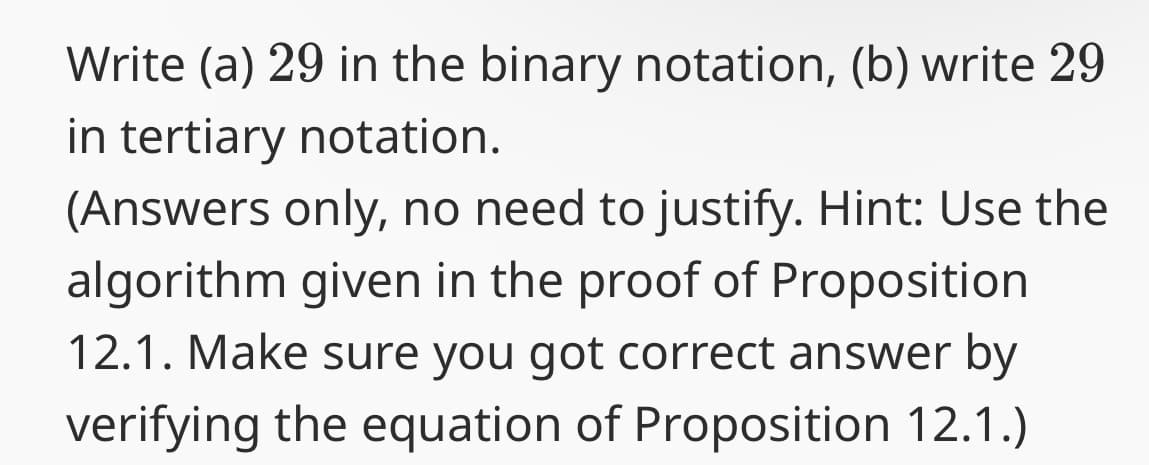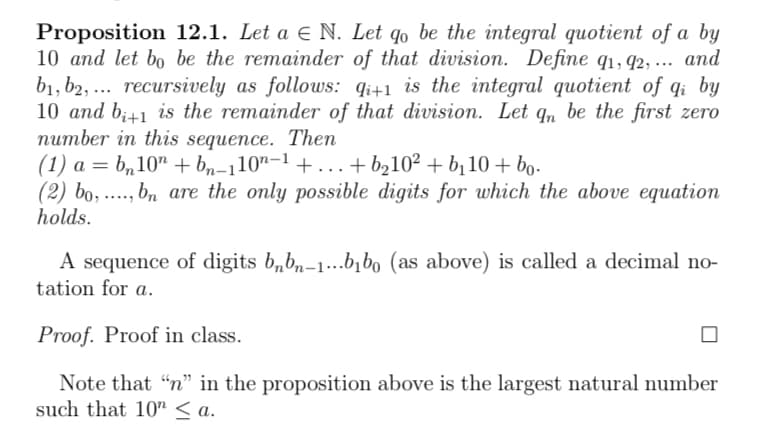Write (a) 29 in the binary notation, (b) write 29 in tertiary notation. (Answers only, no need to justify. Hint: Use the algorithm given in the proof of Proposition 12.1. Make sure you got correct answer by verifying the equation of Proposition 12.1.)
Write (a) 29 in the binary notation, (b) write 29 in tertiary notation. (Answers only, no need to justify. Hint: Use the algorithm given in the proof of Proposition 12.1. Make sure you got correct answer by verifying the equation of Proposition 12.1.)
Database System Concepts
7th Edition
ISBN:9780078022159
Author:Abraham Silberschatz Professor, Henry F. Korth, S. Sudarshan
Publisher:Abraham Silberschatz Professor, Henry F. Korth, S. Sudarshan
Chapter1: Introduction
Section: Chapter Questions
Problem 1PE
Related questions
Question
Please help me out with this question

Transcribed Image Text:Write (a) 29 in the binary notation, (b) write 29
in tertiary notation.
(Answers only, no need to justify. Hint: Use the
algorithm given in the proof of Proposition
12.1. Make sure you got correct answer by
verifying the equation of Proposition 12.1.)

Transcribed Image Text:Proposition 12.1. Let a € N. Let go be the integral quotient of a by
10 and let bo be the remainder of that division. Define q1, 92, ... and
b1, b2, recursively as follows: qi+1 is the integral quotient of qi by
10 and b+1 is the remainder of that division. Let qn be the first zero
number in this sequence. Then
(1) a = b₂10n+bn−110n−1 +...+b210² + b₁10+ bo-
(2) bo, ,bn are the only possible digits for which the above equation
holds.
A sequence of digits bnb-1...b₁bo (as above) is called a decimal no-
tation for a.
Proof. Proof in class.
Note that "n" in the proposition above is the largest natural number
such that 10" <a.
Expert Solution
This question has been solved!
Explore an expertly crafted, step-by-step solution for a thorough understanding of key concepts.
This is a popular solution!
Trending now
This is a popular solution!
Step by step
Solved in 4 steps with 7 images

Knowledge Booster
Learn more about
Need a deep-dive on the concept behind this application? Look no further. Learn more about this topic, computer-science and related others by exploring similar questions and additional content below.Recommended textbooks for you

Database System Concepts
Computer Science
ISBN:
9780078022159
Author:
Abraham Silberschatz Professor, Henry F. Korth, S. Sudarshan
Publisher:
McGraw-Hill Education

Starting Out with Python (4th Edition)
Computer Science
ISBN:
9780134444321
Author:
Tony Gaddis
Publisher:
PEARSON

Digital Fundamentals (11th Edition)
Computer Science
ISBN:
9780132737968
Author:
Thomas L. Floyd
Publisher:
PEARSON

Database System Concepts
Computer Science
ISBN:
9780078022159
Author:
Abraham Silberschatz Professor, Henry F. Korth, S. Sudarshan
Publisher:
McGraw-Hill Education

Starting Out with Python (4th Edition)
Computer Science
ISBN:
9780134444321
Author:
Tony Gaddis
Publisher:
PEARSON

Digital Fundamentals (11th Edition)
Computer Science
ISBN:
9780132737968
Author:
Thomas L. Floyd
Publisher:
PEARSON

C How to Program (8th Edition)
Computer Science
ISBN:
9780133976892
Author:
Paul J. Deitel, Harvey Deitel
Publisher:
PEARSON

Database Systems: Design, Implementation, & Manag…
Computer Science
ISBN:
9781337627900
Author:
Carlos Coronel, Steven Morris
Publisher:
Cengage Learning

Programmable Logic Controllers
Computer Science
ISBN:
9780073373843
Author:
Frank D. Petruzella
Publisher:
McGraw-Hill Education